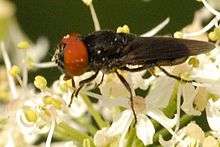Chrysogaster solstitialis
| Chrysogaster solstitialis | |
|---|---|
 | |
| male | |
 | |
| female | |
| Scientific classification | |
| Kingdom: | Animalia |
| Phylum: | Arthropoda |
| Class: | Insecta |
| Order: | Diptera |
| Family: | Syrphidae |
| Genus: | Chrysogaster |
| Species: | C. solstitialis |
| Binomial name | |
| Chrysogaster solstitialis (Fallén, 1817) | |
| Synonyms | |
Chrysogaster solstitialis is a European species of hoverfly.[1]
Description
External images For terms see Morphology of Diptera
Wing length 6-7·25 mm. Antennae reddish. In front view the distance between the eyes at most equal to the width of an eye. Wings blackish-tinged.Female thorax with purplish reflections. The male genitalia are figured by Maibach, A. & Goeldlin de Tiefenau (1994).[2] [3] [4] [5] [6] The larva is illustrated by Rotheray (1993).[7]
Distribution
Palaearctic.Ranges from Fennoscandia South to Iberia and the Mediterranean basin, including North Africa.From Ireland Eastwards through of Europe into European parts of Russia, Ukraine and the Caucasus mountains.[8] [9]
Biology
Habitat:Wetland and deciduous forest, woodland streams and ponds including Salix carr. Flowers visited include white umbellifers, Cornus, Filipendula, Galium, Sambucus, Senecio jacobaea. The flight period is June to September ( May in southern Europe). The larvae live in pond mud containing debris of fallen twigs and branches.[10] [11]
References
- ↑ Stubbs, Alan E.; Falk, Steven J. (1983). British Hoverflies: An Illustrated Identification Guide (2nd (revised) ed.). British Entomological & Natural History Society. p. 253, xvpp. ISBN 0-9502891-3-2.
- ↑ Maibach, A. & Goeldlin de Tiefenau, P. (1994) Limites génériques et caractéristiques taxonomiques de plusieurs genres de la Tribu des Chrysogasterini (Diptera: Syrphidae) III. Descriptions des stades immatures de plusieurs espèces ouest-paléarctiques. Rev.suisse Zool., 101: 369-411.
- ↑ Van Veen, M. (2004) Hoverflies of Northwest Europe: identification keys to the Syrphidae. 256pp. KNNV Publishing, Utrecht.addendum
- ↑ Van der Goot,V.S. (1981) De zweefvliegen van Noordwest - Europa en Europees Rusland, in het bijzonder van de Benelux. KNNV, Uitgave no.32: 275pp. Amsterdam.
- ↑ Bei-Bienko, G.Y. & Steyskal, G.C. (1988) Keys to the Insects of the European Part of the USSR, Volume V: Diptera and Siphonaptera, Part I. Amerind Publishing Co., New Delhi. ISBN 81-205-0080-6.
- ↑ Coe, R.L. (1953) Diptera: Syrphidae. Handbks.ident.Br.insects, 10(1): 1-98. R.ent.Soc.London. pdf
- ↑ Rotheray G., 1993 Colour Guide to Hoverfly Larvae Diptera, Syrphidae in Britain and Europe Dipterists Forum pdf
- ↑ Fauna Europaea
- ↑ Peck, L.V. (1988) Syrphidae. In: Soos, A. & Papp, L. (eds.) Catalogue of Palaearctic Diptera, 8: 11-230. Akad.Kiado, Budapest.
- ↑ de Buck, N. (1990) Bloembezoek en bestuivingsecologie van Zweefvliegen (Diptera, Syrphidae) in het bijzonder voor België. Doc.Trav. IRSNB, no.60, 1-167.
- ↑ Speight, M.C.D. (2011). "Species accounts of European Syrphidae (Diptera)" (PDF). Syrph the Net, the database of European Syrphidae. 65: 285pp.